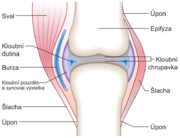Joint tumors
These tumors often arise both directly from the joints and from the surrounding structures. In the first case, we distinguish between synovial osteochondromatosis, vilonodular pigmented synovitis and synovial sarcoma. Hemangiomas , lipomas , fibromas or neurofibromas can develop from the surrounding structures .
Synovial osteochondromatosis[edit | edit source]
This is a benign finding of multiple intrasynoval chondromas that can ossify from the center of the lesion. They appear as oval deposits in the synovial membrane, causing a nodularly swollen joint surface. The tumor is sharply demarcated, it can rarely malignate in chondrosarcoma . It causes movement disorders, so-called articular mice, caused by the rupture of the synovial membrane with cartilaginous nodes.
Vilonodular pigmented synovitis[edit | edit source]
It is a diffuse giant cell tumor in the synovial lining of the tendon sheaths, completely benign. It is formed by thickening of the synovial membrane, which is villous and nodularly swollen on the surface. Brown pigmentation with hemosiderin is typical . The treatment is performed by extirpating the tumor, which prevents the destruction of the joint. Histologically we find increased synovial cells A and B.
Synovial sarcoma (malignant synovialioma)[edit | edit source]
It is a high-grade malignant tumor of young adult age, also referred to as soft tissue carcinosarcoma (according to the expression of epithelioid markers). It can occur anywhere, most often around large joints (typically the knee), which is why it is named, but it does not come from synovial cells and has nothing to do with the joint other than localization. The essence of the origin is translocation with the formation of a fusion transcript.
We distinguish:
- monophasic - jelly-like, fleshy, less differentiated; if it consists only of spindle cells, it is called monophasic spindle cell , and if it consists only of glandular cells, then it is glandular sarcoma
- biphasic - formed by spindle-shaped and glandular mucous cells, similar to endometrial cells
The tumor often relapses and metastasizes to the lungs . Therapy is difficult - resection is necessary; responds poorly to chemo- and radiotherapy.
Links[edit | edit source]
Related articles[edit | edit source]
Referenece[edit | edit source]
- POVÝŠIL, Ctibor – ŠTEINER, Ivo – DUŠEK, Pavel, et al. Speciální patologie : Basisübungen für alle Sportarten. 2. edition. Praha : Galén, 2007. 430 pp. ISBN 978-807262-494-2.

